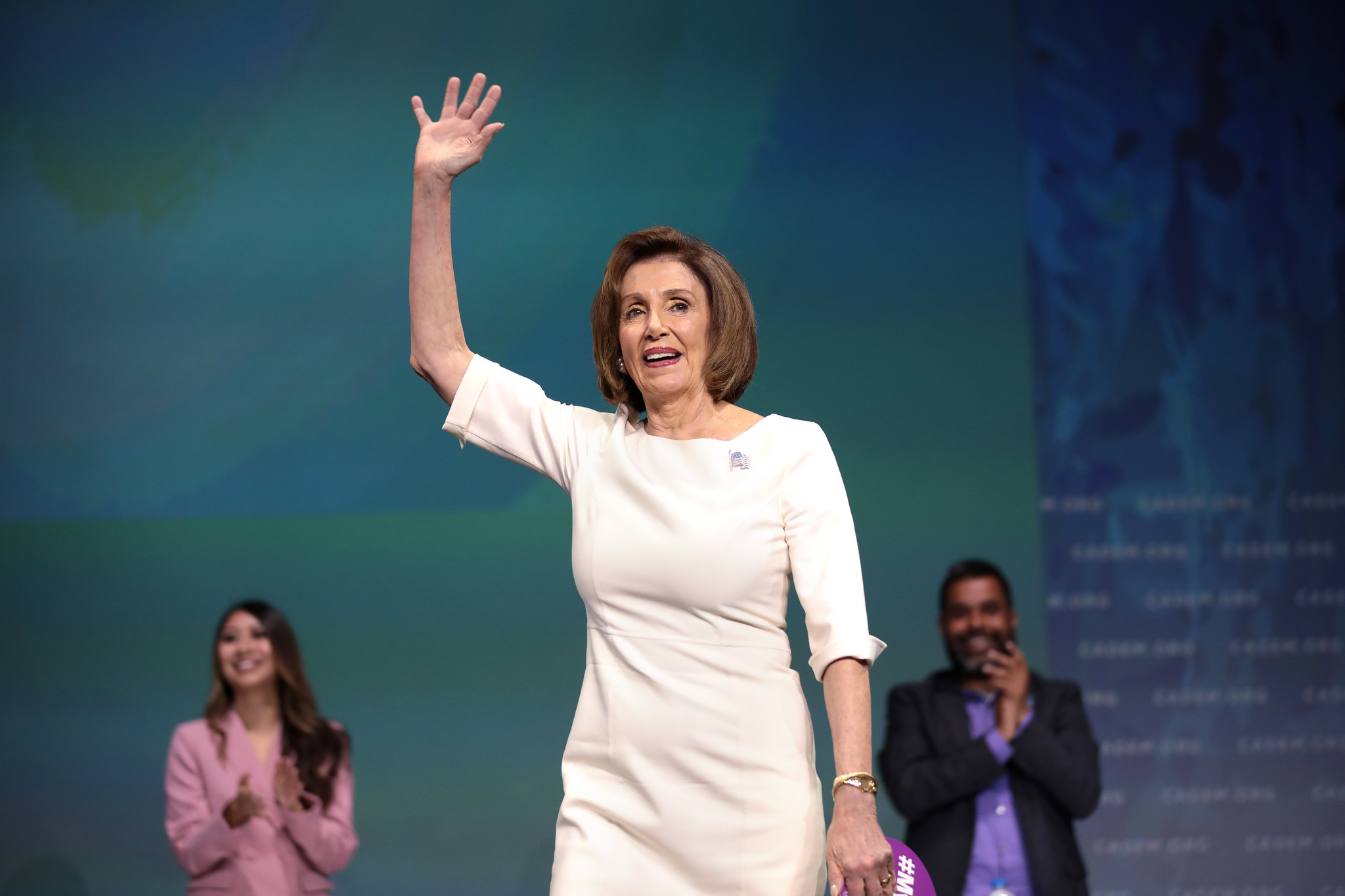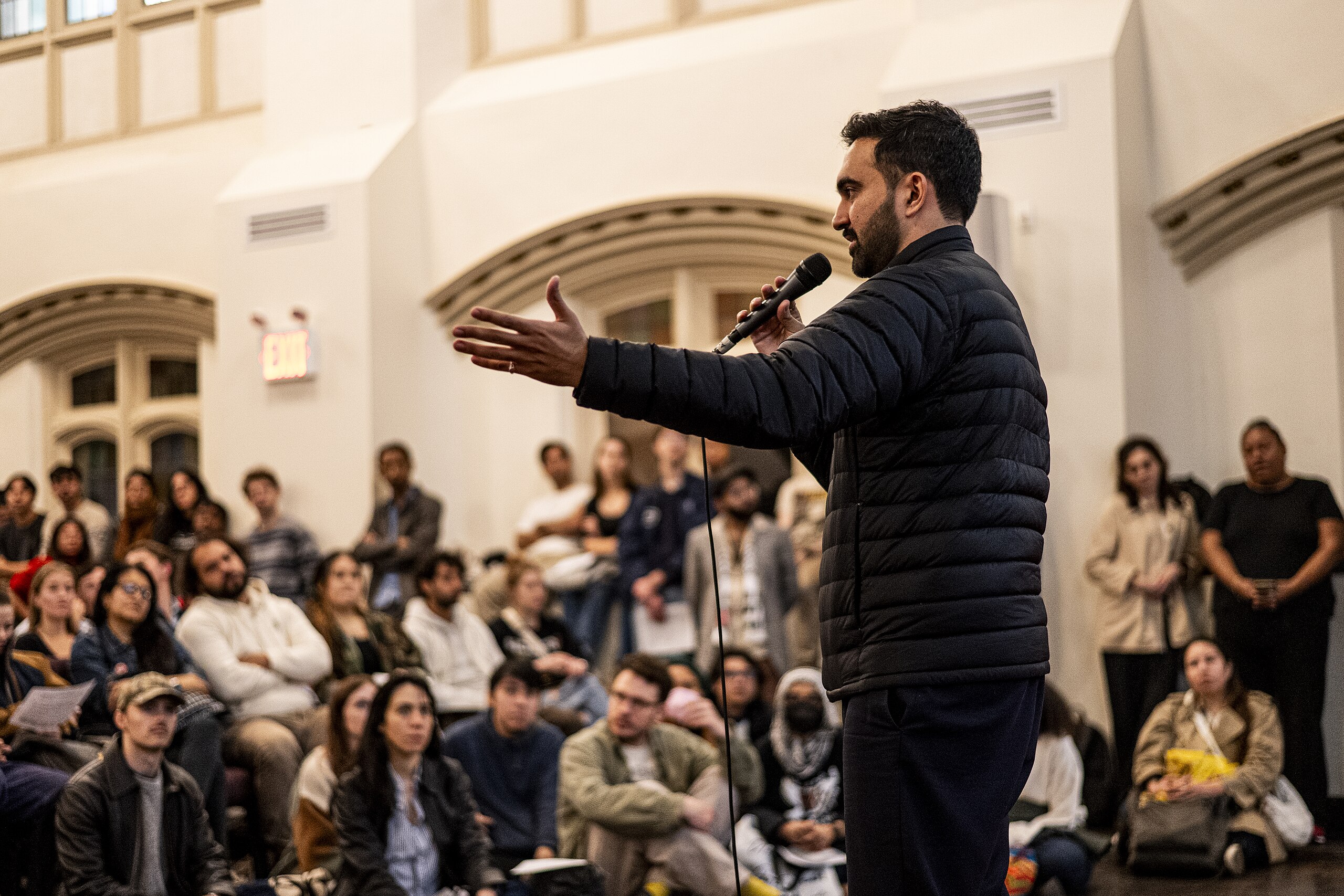If you like this piece, read more about where we stand and sign up to get our occasional email bulletins!
For Democrats, the results of the midterms — much like the campaign they waged — were lackluster. Although to everyone’s relief they managed (just barely) to retake the House, what should have been a blowout turned into a long slog.
With an eye towards developing a sober assessment of what happened on Tuesday and a plan for moving forward, we at The Call spent yesterday cranking out a Marxist analysis of the election results. We’ve got six key takeaways.
1. The Numbers Don’t Lie: The Democrats Botched This
Let’s start with “just the facts.” In the House, Democrats likely increased their seats from 193 to somewhere between 220 and 230. That gives them a small majority, enough to stop the Republican’s legislative agenda, but just barely. But it’s a damning fact that Democrats were only able to pick up about 30 seats when the leader of the opposite party is so deeply unpopular. Republicans running against Obama in 2010 picked up twice as many seats — even though Obama was more popular then than Trump is now.
In the Senate, Democrats did considerably worse, slipping from 47 seats (the two independents who caucus with the Democrats, including our favorite Bernie Sanders, easily won reelection) to 44 or 45 seats, depending on what happens in Arizona and Florida. That’s a serious blow to those hoping to block the White House’s agenda. With a much larger majority in the Senate, Trump will likely pivot to appointing judges and reorganizing his cabinet.
Worse still, Democrats likely won’t have many more opportunities in 2020 to pick up seats, which means that they’ll likely have to wait four years to have a serious chance at retaking Congress’s second chamber. That’s bad news for those holding out hope that after the next elections we’ll have a united Democratic government — one in which Democrats’ supposed commitment to progressive policies could be tested.
Democrats did somewhat better in gubernatorial elections, winning hotly contested races in Kansas, Nevada, and Wisconsin. That last one is particularly satisfying as union-buster Scott Walker was defeated. Unfortunately, however, the impact of Walker’s anti-union crusade, which halved union density in Wisconsin, will likely be felt for a long time. Overall, Democrats will go into 2019 with an increased profile in state governments — with 23 gubernatorial mansions (assuming, as seems likely, they lose in Georgia) to 27 for the Republicans. And at the crucial but oft-forgotten state legislative level, Democrats managed to flip six chambers and take full control (governor, state house, and state senate) in six states — bringing the total states under Democratic control to 14 compared to the GOP’s 21.
In Florida, Iowa, and Ohio (we still don’t know what will happen in Georgia), however, Democrats lost bellwether gubernatorial races. Especially bitter for those of us on the Left is Andrew Gillum’s narrow defeat to Trump-acolyte Ron DeSantis. Gillum was the Berniecrat who won a surprise primary victory in September against six establishment Democrats. Gillum proudly campaigned on Medicare for All and other progressive policies but faced a general turn against Democrats in the final month among voters and countered with a questionable decision to enlist the support of Hillary Clinton and other corporate Democrats.
The losses in these three states are a bad sign for 2020. They show that Republicans retain a strong foothold in key battlegrounds despite the last two years — and in Ohio, where the Democrat was expected to win, it wasn’t even that close. But holding the governor’s mansions will also empower Republicans to do what they do best: tamper with the election process and further disenfranchise voters in order to ensure victory in close races in the future.
2. The Democrats Don’t Have a Strategy to Beat Trump
What turned the expected “blue wave” into a “blue trickle?” As we warned in our last two monthly bulletins, the Democratic Party’s strategy for this election should have set off alarm bells long ago.
The Democrats were at a disadvantage from the start, due to the profoundly undemocratic political system in the United States. But a winning strategy needs to take the actual state of things into account.
Instead, the Democrats continue to systematically underestimate the depth of alienation and discontent with mainstream politics that is evident all across the country — but especially in rural corners left behind by the economic recovery. And the party continues to pursue a doomed strategy of focusing on affluent suburbs, trying to win over the last remaining liberal and moderate Republicans among the professional-managerial class while courting the rich and powerful to fund their campaigns.
No Platform for Working People
Did the Democrats have a clear message this year? Numerous talking heads and Democratic consultants claimed in the last few weeks that healthcare was the party’s main issue, but what was the solution they rallied people around? It certainly wasn’t Medicare for All. At best, it was the tired old refrain: “Vote for us, we’ll protect Obamacare.”
In the end, the only unifying thread to the Democratic campaign was a pledge to restore “decency” to politics. Barack Obama put the party’s message best:
“People of both parties should be concerned about our current course and the basic institutions of our democracy, and should want to see a restoration of honesty, decency, and lawfulness to our government. And should want to see some checks and balances on what’s happening right now… On November 6th, we have a chance to restore some sanity to our politics.”
“Vote for us, we’re decent!”
It should be clear by now that message just isn’t going to work.
It’s time to bury the so-called “resistance” and all that came with it. The kvetching about Russia, Putin, and corruption. The appeals to “restore sanity.” These are losing messages, ones that will fail to mobilize the huge majorities of working and middle-class people necessary to beat the Right.
The Democrats Can’t Win by Courting the Rich and Comfortable
The Democrats paired a weak message with precisely the same strategy as 2016: focus on affluent suburbs where Republicans once dominated. An analysis by The New York Times showed that more than a third of the districts where Democrats chose to focus their resources and attention were in the top 20% of districts in terms of prosperity.
This is the same basic strategy that the Democratic Senate leader Chuck Schumer lauded two years ago: “For every blue-collar Democrat we lose in western Pennsylvania, we will pick up two moderate Republicans in the suburbs in Philadelphia, and you can repeat that in Ohio and Illinois and Wisconsin.”
The fact is, that just won’t work. Unfortunately, it is becoming ever clearer that the leaders of the Democratic Party would prefer losing with an upper-class base than winning with a working-class one.
But the Democrats’ rotten pact with those on top goes far beyond depending on them for votes.
While we were canvassing for democratic socialists and casting our ballots, our enemies in the capitalist class and their allies in the professional-managerial class were playing a very different game. It’s a game with, as Thomas Ferguson puts it, a single “golden rule.” The rule of the game is this: Those with the gold rule.
In every race, up and down the country, cash flowed freely as the wealthy placed their bets on candidates and those in power jockeyed to secure influence. This midterm election will easily be the most expensive one in history — more than $5 billion flooded into Democratic and Republican operations.
The result was that the only real wave this year was green. Expecting a Democratic victory — and in many cases even hoping for one — those on top reorganized their political “investment portfolios” and bought shares in the Democratic Party. And Democrats happily played along and further moderated their message to attract investments.
As Open Secrets reports, even before October more than 50% of donations from major donors and PACs linked to Wall Street, hospitals, Big Pharma, lawyers, and consultants went to Democratic candidates. But in the last month that turn became even more dramatic. Wall Street donors increased their donations to Democrats by 20% points (about 70% of donations in the last month from the finance, securities, and investment industries have been “blue”) and hospital executives and doctors made a 30% point swing (so that in the last month 86% of donations have gone to Democrats).
CEOs and PACs in industries less favorable to the center left also saw the light, it appears. Donations from the insurance industry went from 39% to 52% and real estate shifted from 39% to 60% for Democrats. Even donors from the oil and gas industry, supposedly erstwhile opponents of a party that talks a big game about the perils of climate change, shifted towards Democrats.

For regular people trying to figure out where the Democrats are headed, major swings made by those most opposed to Medicare for All, 100% renewable energy, and financial regulations should serve as a reminder of precisely what we can expect. The Democratic Party has been and will continue to be one of the two political vehicles for the capitalist class and its interests. As the fortunes of the Republican Party have waned, savvy “political investors” in the capitalist class shifted their dollars “to the left.” As we discuss below, Nancy Pelosi and the congressional Democratic Party leadership intend to return the love by putting together a tepid agenda for 2019.
But what about the legendary small donors? Aren’t Democrats more free than they’ve ever been from the control of the elite because of these small donors’ generosity?
The answer is no, although a few major candidates this cycle bucked the trend. Alexandria Ocasio-Cortez and Bernie Sanders raised two-thirds and three quarters (respectively) of their donations from small donors giving less than $200. But it is hard to overstate how exceptional numbers like that are. Among serious candidates who received a majority of their donations from small donors, Bernie and AOC were joined by a couple of Our Revolution–endorsed candidates in solidly Republican congressional districts, Elizabeth Warren, and Congressional Progressive Caucus–endorsed candidates John Lewis (Georgia) and Randy Bryce (Wisconsin).
The myth of the small donor props up illusions about the Democrats’ political independence. But the reality is that the vast majority of Democrats — including members of the Congressional Progressive Caucus — remain primarily beholden to corporate donors and very affluent professionals and managers.
Sadly, contributions from unions hardly made a difference. A handful of progressive Democrats rely on union PACs for about a third of their campaign donations, but the remainder of their money still comes from big donors.
And unions themselves are still not reliable advocates for anything resembling a progressive political agenda. Setting aside the major donations they’ve made to corporate Democrats this year, even relatively progressive unions contributed significant sums to Republicans. This was true even in competitive districts like Pennsylvania District 1, where Scott Wallace — who was endorsed by the Congressional Progressive Caucus — lost to Republican Brian Fitzpatrick. Fitzpatrick raked in major donations from unions including the American Postal Workers Union (the APWU endorsed Bernie Sanders in 2016) and UNITE HERE.
3. Socialists Made Important Gains
The biggest bright spot in 2018 was the victory of a handful of democratic socialists who ran insurgent campaigns across the country. At the federal level, Alexandria Ocasio-Cortez and Rashida Tlaib won their elections to Congress and will join Bernie Sanders on the left-most edge of national politics. As Bhaskar Sunkara has suggested in Jacobin, it’s time for them to form a democratic socialist caucus in Congress.
But democratic socialists made our biggest gains at the state level. Before Tuesday, and by our count (if we’re missing anyone in the list below please let us know!), Democratic Socialists of America (DSA) members Lee Carter in Virginia, Kaniela Ing in Hawaii, Mike Sylvester in Maine, and Mike Connolly in Massachusetts were the only democratic socialists in state legislatures.
Minus Ing — who didn’t run for reelection — the others will now be joined by Amy Perruso (Hawaii); Gabriel Acevero and Vaughn Stewart (Maryland); Jade Bahr (Montana); Julia Salazar (New York); and Elizabeth Fiedler, Sara Innamorato, and Summer Lee (Pennsylvania).
That brings DSA’s representation in state legislatures from 4 to at least 11. A drop in the bucket of the total 7,383 state legislative seats in the country but an important advance nonetheless. We still don’t know whether Jovanka Beckles (California), Amelia Marquez (Montana), and Kristin Seale (Pennsylvania) will pull through, though all three are currently trailing their opponents.
While holding out hope, if Beckles doesn’t make it, it will be a tough loss for the Left. No race better “heightened the contradictions” between democratic socialists and the Democratic Party in the general election. Jovanka Beckles ran on a strong platform supporting Medicare for All, rent control, and tuition-free public college education. Endorsed by Bernie Sanders, Beckles was up against Buffy Wicks, favorite candidate of the capitalist class and endorsed by Barack Obama. Nevertheless, East Bay DSA ran a fantastic campaign that can serve as a model for other DSA chapters around the country.
At a local level, DSA candidates also did well in Houston — where Franklin Bynum, a strong opponent of mass incarceration, was elected to the Criminal Court — and a handful of other cities. You can find a full list of DSA-endorsed local candidates here.
What comes next for DSA’s elected candidates?
In many ways these first elected democratic socialists will be “guinea pigs” as DSA tries to figure out how to turn its election-day muscle into a force in the grinding, pro-business swamps that are America’s legislatures. As we’ve said before, the task of elected democratic socialists is to be tribunes for the working class — fighters who use their office to organize and promote class politics.
Our newly elected representatives can’t fall for the trap of trying to “build trust with their colleagues” — colleagues who owe their election to the capitalist class and affluent professionals. Nor should they wrongly stoke hopes that they’ll be able to play a meaningful role in developing policy. They’re class warriors dropped behind enemy lines, and they must act accordingly.
No doubt the transition will be a tough one. DSA has been relatively open-minded and trusting in the candidates it has endorsed, and 2019 will be the first test of whether or not we can push elected socialists in a more leftward direction. Most likely, the results of this first red wave will be mixed. Expect more commentary from us at The Call in the future about the lessons learned and what we need to do to build an even more powerful socialist project.
4. Progressives Had a Mixed Night
An even thornier question for socialists moving forward is what our relationship to progressive Democrats should be.
In Congress, the Congressional Progressive Caucus (CPC) had 75 members before Tuesday. That amounted to about 40% of Democratic seats. By our count, if you total up all the re-elected members of the caucus and victorious incoming representatives endorsed by the CPC’s PAC and/or Bernie Sanders’s Our Revolution, the membership of the caucus in Congress will grow to 87 — which leaves its proportional share of Democratic seats unchanged at 40%. There are another seven outstanding races though that could be won by CPC-endorsed candidates.
The Congressional Progressive Caucus (CPC) is a mixed bag. It includes members who socialists have significant disagreements with but who are more-or-less genuine advocates for key issues of interest for the working class. We’d count representatives like Barbara Lee of California and Raúl Grijalva of Arizona among that number. But it also includes much more questionable characters like Carolyn Maloney of New York and Joseph P. Kennedy III of Massachusetts. And importantly, unlike the right-wing Freedom Caucus, the CPC makes no effort to enforce voting en bloc, making it ineffective at extracting demands from Democratic congressional leadership.
DSA and democratic socialists did not support Congressional Progressive Caucus members in the general election. But it’s an open question how we should relate to its more genuine members, one which we need to spend a lot more time thinking seriously about.
Progressive candidates also weren’t the only ones on the ballot. Across the country, working and middle-class people voted for a number of important referenda that will shift parts of the country in a leftward direction. In Florida, 65% of voters supported restoring voting rights to people previously convicted of a felony — that effectively gives the vote back to more than a million people. In New York City, 80% of voters supported an expansion of public financing of elections. Large majorities in Idaho, Nebraska, and Utah voted to expand Medicaid. In Arkansas and Missouri, 68% and 62% of voters respectively supported raising the minimum wage. And following the massive teacher strikes in Arizona, voters there overwhelmingly rejected a proposal to shift money from public schools to private school vouchers.
Unfortunately, not every progressive referendum passed. In California, Proposition 10, which would have repealed state restrictions on local rent control, lost resoundingly. In Massachusetts, a safe-staffing bill, which would have reduced nurses’ workload, also went down in defeat. And in Colorado, a proposition to make fracking more difficult lost. That proposal was opposed by the mainstream of the Democratic Party, including Jared Polis, who won the gubernatorial race in the state last night (and to our point above, was also a member of the Congressional Progressive Caucus).
5. Nancy Pelosi Has No Plan
Unsurprisingly, Nancy Pelosi and her team are preparing a thin gruel for 2019. If you read between the lines of what Democrats say will be their priorities next year, some consensus seems to have been reached that they’ll focus on tweaks to prescription drug prices and campaign finance. They’re also holding out hope that they can work with Donald Trump on an infrastructure bill. On the latter bill Steny Hoyer, the Democratic leader in the House, giddily confessed that Trump’s “objectives are objectives that we share.”
One would think that after all these years Democrats would learn that a) you can’t win by calling for bipartisanship with the Republican Party and b) working and middle-class people are not going to rally around incremental reforms. Democrats would do much better to study the Republican playbook after the 2010 midterms. After winning, Republicans used the following six years to hammer away at Barack Obama and prepare a legislative agenda that included repealing Obamacare and slashing taxes for the rich. In other words: They knew what it would take to inspire and build their conservative and well-heeled base.
Instead, it falls on socialists to find a way to expose the Democratic Party in Congress and convince people that we need an alternative. Most importantly, we need to demand hearings on a Medicare-for-All bill — and to do so, progressives in the Democratic majority need to be put on the spot. Will they demand that Pelosi and her team give them space to craft and prepare a full Medicare-for-All bill that can be at the center of the 2020 election? If anything good can come from this coming Congress, it’s that.
6. What Comes Next
Friedrich Engels once praised elections for acting as thermometers that indicate the level of class consciousness and polarization. Despite our deeply anti-majoritarian political system and the ridiculous character of our two parties of business, this year’s midterms may yet tell us something along those lines.
First, we know that Democrats are still in a far greater crisis than they admit. They have no strategy for winning back a small but important layer of primarily white working-class voters in rural parts of the country — the very voters who were critical to Obama’s victories in 2008 and 2012 but have since abandoned the Democrats. Had Democrats been able to win back their support, elections in Florida, Georgia, Iowa, Missouri, Ohio, and elsewhere would not have gone as poorly as they did. And a lot more congressional districts — especially in poor parts of the country — would have been competitive.
Second, Democrats will do everything they can to beat the new socialist movement. That first fact was on full display in East Bay, where Democrats pulled all the stops, raising millions of dollars (with help from Republicans too), and enlisting major endorsements — including from Obama himself! — to oppose DSA candidate Jovanka Beckles for a state assembly race.
Finally, socialists need to have a clear message going forward, one that doesn’t fall back on a noxious trope common among liberals that accuses all working people who don’t vote Democrat of being ignorant reactionaries.
We need a clear message that starts instead with a basic argument — it’s not working people’s fault that Democrats have failed to build a permanent, popular majority against the Right.
Defeats like Gillum’s in Florida can’t be written off as the product of widespread racism and sexism. Certainly, there’s a small layer of white reactionaries who are utterly opposed to any message from liberals or socialists. But the vast majority of people are open to real class politics and abhor oppression and prejudice. After all, it’d be a peculiar white supremacist majority in Florida who could simultaneously vote against Gillum out of deep-seated prejudice and also vote to bring suffrage back to more than a million people formerly convicted of felonies.
The referenda victories for Medicaid expansion, raising the minimum wage, and fighting back against the tentacles of mass incarceration in red states are strong indications that a large majority of people are ready to rally around a politics that foregrounds class-wide demands.
That’s not what the Democratic Party is offering of course. As a result, a smart person would look at the results from Tuesday and place a bet on Trump winning reelection, assuming a major shakeup doesn’t occur.
To stop that from happening, socialists need to persuade ever-greater numbers of people that we are the ones with a real strategy to beat the Right.
It won’t come just or even primarily through elections. Our immediate next steps must be to pivot to strengthening social movement campaigns for redistribution and freedom — as New York City DSA is already preparing to do with its demand to expand rent regulations this spring.
In the near term, we also need to prepare for even bigger confrontations with the Democratic establishment as the 2020 primary sets up a major battle between Bernie Sanders and the rest of the party.
This week though, clarity is the order of the hour. Clarity about a key point: The Democratic Party scorned working people and tried to build a coalition of Obama Democrats and Rockefeller Republicans. That coalition was enough to eke out a victory in the House but not much more. For everyone who wants to beat Trump and build a better world, it’s time to look leftward.




